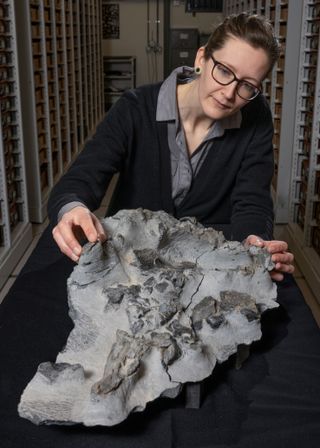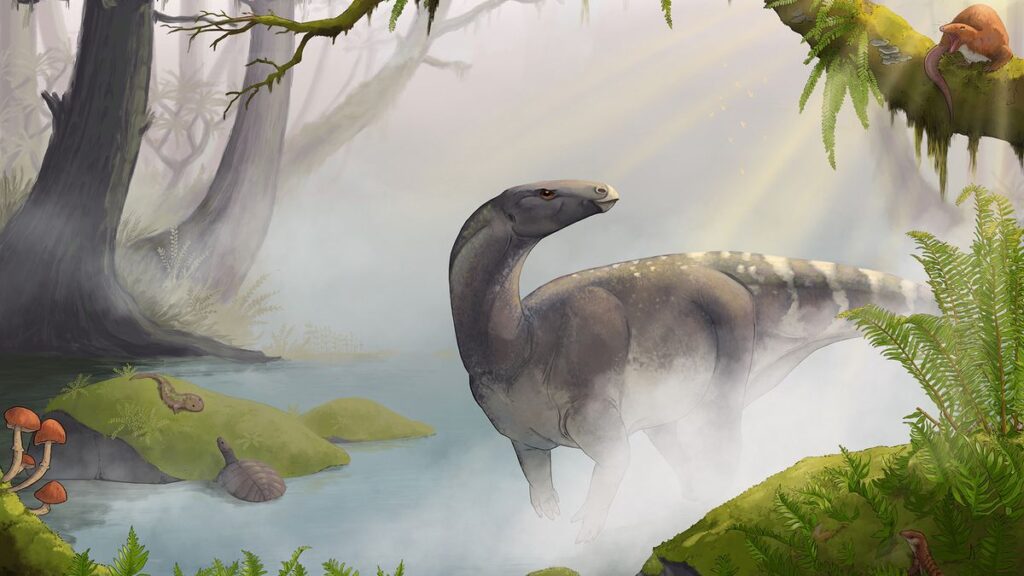A fossil first discovered over 50 years ago has finally been identified as the remains of a pony-sized dinosaur that lived about 166 million years ago.
The fossil was spotted at the base of a cliff on the Isle of Skye in Scotland in 1973, but it was not collected by paleontologists for another 45 years due to its tricky location.
Now, according to a paper published March 6 in the journal Earth and Environmental Science Transactions of the Royal Society of Edinburgh, this fossil — which includes fragments of a spine, ribs, and hip bones — may be the remains of a dinosaur that lived during the Jurassic Period (201.3 and 145.0 million years ago).
This fossil, nicknamed the “Elgol dinosaur” after the village near where it was found, is now considered the most complete dinosaur fossil ever discovered in Scotland, as well as being the earliest ever unearthed there.
Located off the northwestern coast of Scotland, the Isle of Skye is the location of several dinosaur fossils and footprints from the Middle Jurassic period, which is poorly represented in the global fossil record.
Related: Megalodon may have grown up to 80 feet long — far larger than previous estimates
“This is a wonderful addition to the rapidly growing set of Jurassic finds from the Isle of Skye which are enabling us to learn more and more about the rich ecosystem of the time,” study co-author Stig Walsh, a senior curator of vertebrate palaeobiology at National Museums Scotland, said in a statement.
The newly identified dinosaur may have been about the size of a pony, and was at least eight years old when it died, according to the researchers.
The fossil was first recorded by paleontologists during field trips between 1971 and 1982, with a 1973 notebook entry mentioning “bones of a dinosaur” in a cliff with a small sketch. The original discoverers didn’t realize its significance, and due to its awkward location, it was exceedingly difficult to remove from the ground.

Researchers rediscovered the fragmented fossil in 2015, and itwas eventually excavated and transported from its cliff location in 2018.
“This was a really challenging extraction, in fact we’d previously felt was too difficult to collect the fossil, but I thought it was really important to study it,” study lead author Elsa Panciroli, a NERC Independent Research Fellow at National Museums Scotland, said in the statement.
“I was able to persuade the team to give it a try. It took a lot of hard work from a lot of people, but we did it: finally we can confirm and publish Scotland’s first recorded and most complete dinosaur, and that makes it all worthwhile.”
Paleontologists then studied the fossil using a range of techniques, including micro-CT scanning, which is a non-destructive imaging technique that uses X-rays to create highly detailed 3D images of small objects at a microscopic scale.
The shape and microstructure of the bones, and the fact they were found within the Kilmaluag Formation — a geological formation dating to the Middle Jurassic — indicated that the fossil may be the remains of a cerapodan or ornithopod dinosaur.
Cerapodan dinosaurs are a major group of ornithischian (bird-hipped) dinosaurs, which have a pelvic structure resembling that of modern birds. Ornithopods are one herbivorous sub-group of cerapodans that lived during the Jurassic and Cretaceous periods, and had beaked mouths for cropping vegetation. One of the most well-known groups of ornithopods were Iguanodons, which were one of the first dinosaurs ever named.
If this new dinosaur is indeed ornithopodan, it may be among the earliest ornithischian fossils, and possibly the oldest ornithopodan body fossil in the world.
“Some aspects of the bones indicate that the specimen may be an ornithopod, a group of plant-eating dinosaurs that are best known from the Cretaceous,” study co-author Susie Maidment, a paleontologist at the Natural History Museum in London, said in the statement.
“This specimen, however, would already have been a fossil by the time that the better-known ornithopods like Iguanodon and Hypsilophodon were walking the Earth,” she said. “Recent research on the fossils of Elgol has revealed a diverse ecosystem of extraordinarily preserved Middle Jurassic animals, and I’m sure there are more exciting discoveries to come.”
